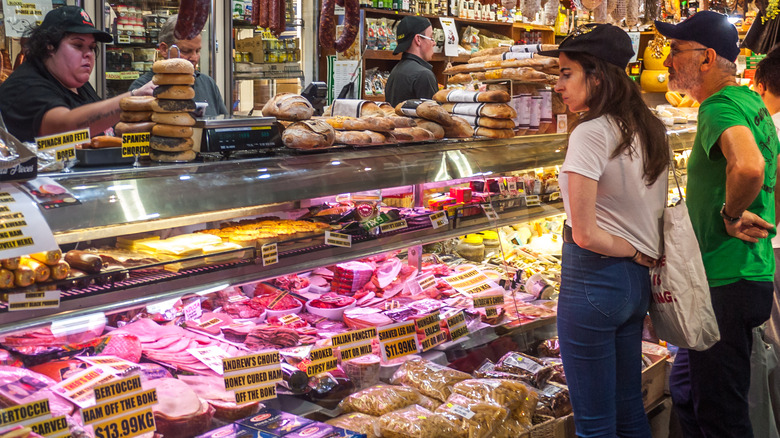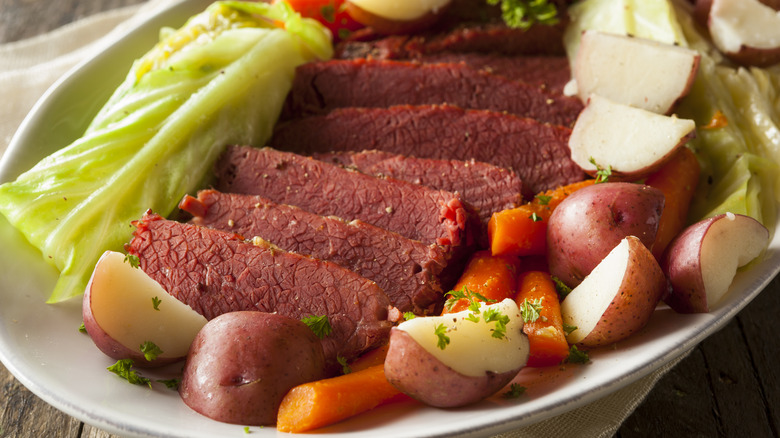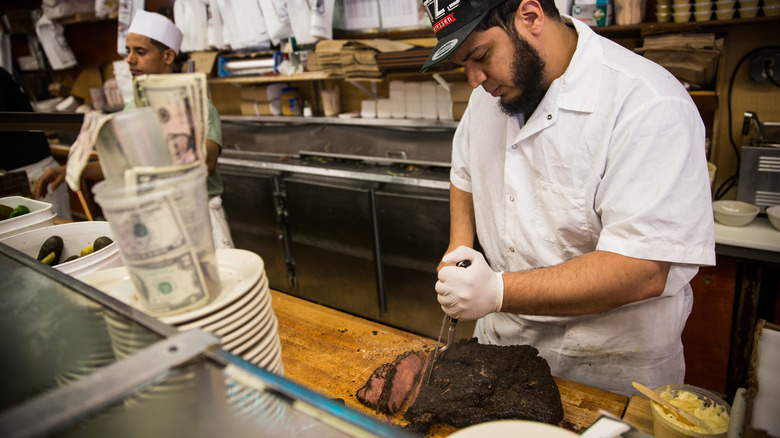What's The Difference Between Corned Beef And Pastrami?
The New York delicatessen is a quintessential part of the American cultural identity. Its ever-growing selection of iconic New York staples serves as an archive for the culinary history of the country. At an ordinary New York deli, you can find anything from classic cold-cut sandwiches, to falafel gyros, to Jamaican beef patties, to breakfast burritos — all of which speak to their respective culture's story of immigration and adaptation of American identity. Of course, any New York deli worth its salt (literally) will almost always have two time-honored deli counter essentials: corned beef and pastrami.
They may have their similarities — sold at many of the same locations, made of beef, and sharing a claim to the Reuben sandwich – but pastrami and corned beef are not as interchangeable as one may think. Not only are corned beef and pastrami distinctly different in their production, but they are foods that tell singular stories of their own cultures coming to America, setting up shop in New York, and finding a better life.
Corned beef in Ireland
First off, the term "corned" in corned beef refers to the kernels of salt that are used during the brining process for preserving meat; it has absolutely nothing to do with maize, according to Katz's Deli (an American institution and foremost authority on deli meats). Katz's uses a recipe for corned beef that simply calls for a beef brisket — the cut used in most corned beef recipes, says Food Network – that is saltwater-brined for several weeks, then slow-boiled, steamed, and carved.
Despite its St. Paddy's Day popularity, corned beef is not a keystone dish in Ireland. In the essay "Irish Corned Beef: A Culinary History," food historian Máirtín Mac Con Iomaire details how Irish-American immigrants have come to be associated with corned beef by way of imperialism and global trade. The essay posits that cattle have always been essential to Irish food and culture — but for their byproducts (milk, butter, cheese) and utility (plowing and transport) rather than meat. Cattle were regarded as symbols of wealth, so certain beef dishes were reserved for special celebrations or for the rich.
During the colonial era, the English occupying Ireland industrialized beef production to export to colonies as a provision for their military. With increased reach, global demand skyrocketed, and the Irish-exported goods became virtually unaffordable to the people producing them. Mac Con Iomaire suggests that corned beef's association with the Irish came from Great Famine-era Irish immigrants delightedly finding abundant, affordable corned beef at kosher-style, Jewish delis in America. In this sense, its popularity can be more attributed to Irish-Americans, or even Jewish-Americans, than to Ireland. So where does pastrami factor in?
Pastrami in America
To put it plainly, pastrami is basically corned beef with extra steps. Both are beef cuts that go through brining, but corned beef is traditionally made exclusively from brisket, while pastrami is made from (but not limited to) the fattier navel cut, Katz's owner Jake Dell explained to Serious Eats. In their pastrami recipe, Katz's Deli brines their meat for weeks (like their corned beef), but afterward, they apply a generous coating of traditional spices (black peppercorns, coriander, and more, says Dell), followed by three days of slow-smoking. Then, the pastrami is boiled for three hours, steamed, and carved to order.
In addition to its meticulous preparation and deliciousness, pastrami is also the story of Jewish immigration to America. In his article "Pastrami Land: The Jewish Deli in New York City," sociologist Harry G. Levine claims pastrami as we know it today is the result of Jewish immigrants' arrival in the U.S. from Eastern and Southeastern Europe, which blended Romanian and Turkish techniques for preserving lamb and other meats with the beef-dominated American culinary scene.
Pastrami's origins trace so far back, it's nearly impossible to specify exactly where it comes from — but it's certainly the product of food fusion due to cultural diaspora and immigration to America. That's partly why in densely populated areas like New York, kosher and kosher-style delis became culinary institutions for Jews and non-Jews alike — no matter which popular deli meat or familiar flavor they were craving.


